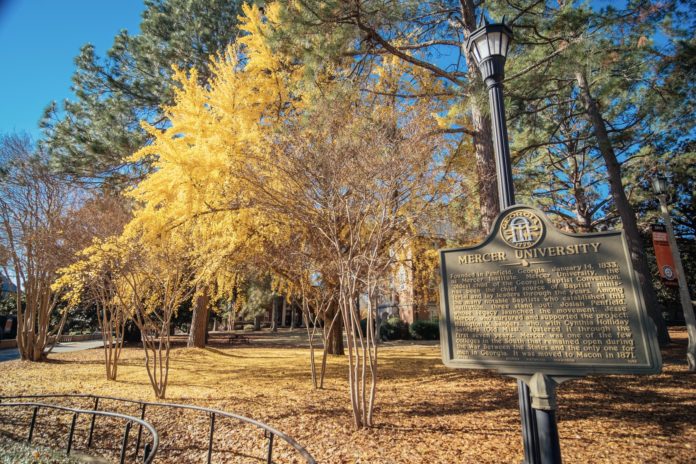Published Sunday, Sept. 3, in The Macon Telegraph
By Jennifer Burk
TELEGRAPH STAFF WRITER
Yosalida Rivero-Zaritzky is thrilled with her new home. It’s a three-minute walk to Mercer University’s campus where she teaches Spanish, and it’s nestled in between two other brand-new homes with perfect paint jobs.
The Beall’s Hill area where Rivero-Zaritzky and her husband, Aaron Zaritzky, live hasn’t always been an adored piece of property.
Less than 10 years ago, the area was home to public housing complex Oglethorpe Homes, and many people deemed it unsafe and run down.
The revitalization is a joint effort by the Macon Housing Authority, Mercer and Historic Macon.
To encourage faculty and staff members to live in the neighborhoods around campus, Mercer pays a portion of a home’s down payment – up to $15,000 at Beall’s Hill – provided that the homeowner lives there for five years.
For the past 10 years, Mercer has been heavily involved in revitalizing neighborhoods around the campus and downtown, and its efforts placed it on a national list in August.
Mercer ranked No. 13 out of 25 on the list, dubbed “Saviors of Our Cities,” for the colleges’ social and economic contributions to their communities. The only other Georgia college to make the list was Emory University at No. 21.
“Increasingly, institutions like Mercer are stepping up … in cities across the country to bring some of their own resources into the equation,” said Peter Brown, director of Mercer’s Center for Community Engagement, formed in 1998. “It’s very unusual for a university to put in its own money that way.”
On the Beall’s Hill project alone, Mercer has put in close to $680,000 in direct costs and an additional $2.2 million in soft costs, such as people and overhead, Brown said.
The university also has brought in $41.75 million in corporate, federal, state and foundation grants for the project, he said.
HOW IT HAPPENED
Mercer hasn’t always been so heavily involved in the community.
“Lots of universities have spent lots of their history sort of rolled up like a hedgehog, always looking to the inside, with their thorny spines to the outside,” said John Hiscox, executive director of the Macon Housing Authority. “Years ago, Mercer was looking almost entirely inward, but they made a conscious decision to look outward.”
In 1996, the Macon Heritage Foundation, which is now Historic Macon, approached the university about getting some of its faculty and staff to live in Huguenin Heights, a newly revitalized neighborhood.
The organization asked Mercer to provide down-payment help for faculty members moving into the neighborhood. Members believed having professors and staff live there would help clean up the area, said Bette-Lou Brown, executive director of Historic Macon and the wife of Mercer’s Peter Brown.
“Mercer’s support in terms of down-payment assistance assured the success,” she said.
That same year business, community and city leaders came together to form NewTown Macon, a group dedicated to revitalizing downtown. Then-Mercer President Kirby Godsey chaired the group and got the university involved in its work.
“The university’s well-being is dependent in part on the well-being of the center city,” said Godsey, who now serves as Mercer’s chancellor, “so we as an institution chose to be involved in the revitalization of downtown and making it an economic, cultural and historic hub of the community.”
Mercer began buying properties downtown. It now owns about 20 downtown parcels, Godsey said, including the property on Martin Luther King Jr. Boulevard between Poplar and Plum streets and a number of properties near The Medical Center of Central Georgia.
Other Mercer downtown projects include leasing the Grand Opera House on Mulberry Street from Bibb County and helping to bring loft apartments downtown by committing to lease the lofts to Mercer students or staff if they did not fill up.
Six years ago, there were about 25 lofts downtown. Now there are about 225, said Mike Ford, president of NewTown.
Mercer also helped rehabilitate the Grand Opera House, which is now home to the Macon Symphony Orchestra and brings around 100,000 people a year downtown, he said.
Mercer is “taking a proactive stand to make these things happen, and nobody else is,” Ford said.
University officials aren’t the only ones stepping out into the community.
About 76 percent of students reported on an exit survey that they have done some sort of service while at Mercer, said Jean Fallis, director of the office of service-learning.
Mentoring students at Burke Elementary School is a typical volunteer project.
Baheejah Hasan, principal of Burke Elementary, said more than 90 Mercer students are coming to her school this year as volunteers.
Younger students, she said, “have the opportunity to have another adult figure share their learning experiences with them.”
ECONOMIC IMPACT
Mercer’s impact also can be felt in the city’s economy.
Each year, around 2,500 students come to Macon to study at the university, and hundreds of faculty and staff live here year round.
An institutions’s economic impact is measured by its spending on instruction, research, public service and capital projects and the spending of students, faculty and staff in the local community, according to a report by the Georgia Foundation for Independent Colleges.
The report estimated Mercer’s annual economic impact, excluding construction, from four of its campus locations at $389.5 million. The four locations were Macon, Atlanta, Douglasville and Henry County.
Chip Cherry, president and CEO of the Greater Macon Chamber of Commerce, said more than half of the $389.5 million is contributed to the Middle Georgia economy. This is about 20 percent of the economic impact of the Medical Center, which is the region’s largest employer, after Robins Air Force Base.
Cherry said more than half of Mercer’s economic impact would go to Middle Georgia because the Macon campus is the largest and is residential.
Students who live on campus generate more activity than commuter campuses. More jobs need to be created to serve the students when they come, he said.
Students accounted for 40 percent of Mercer’s economic impact, according to the report.
Macon Mayor Jack Ellis notes that Mercer is not the only higher-educational institution to contribute to Macon’s well-being.
Macon State College, Wesleyan College, Fort Valley State University, Central Georgia Technical College and Middle Georgia Technical College all help the community, he said.
“They have contributed a lot,” he said. “All of them have.”
Ellis said Mercer buying property downtown can be good and bad for the city. It’s good because the buildings get rehabilitated, he said, but it’s bad because the property leaves the city’s tax rolls since Mercer is a nonprofit.
Peter Brown acknowledges that there is a “healthy dose of self-interest in Mercer’s involvement.”
Cleaning up neighborhoods around Mercer, he said, gives faculty, staff and students a better place to live and helps advance the university’s educational mission.
“The stewardship for our neighborhood was an important agenda for the university,” Godsey said. “We couldn’t just exist in the area as an intellectual enclave.”
To contact Jennifer Burk, call 744-4345 or e-mail jburk@macontel.com.
AT A GLANCE
The ‘Saviors of Our Cities’ list, compiled by Evan Dobelle, president of the New England Board of Higher Education, was based on 10 criteria, including:
How long the college has been involved with the community
The ‘real dollars’ it has invested in the community
The college’s presence in the city, based on payroll, research and purchasing power
Faculty and staff involvement in community service
The college’s ability to sustain neighborhood initiatives
Mercer University’s role in downtown
Down-payment assistance to faculty and staff moving into neighborhoods around campus
Rehabilitated the Grand Opera House
Assisted in bringing lofts downtown
Student community service projects, such as mentoring
Estimated economic impact: nearly $200 million









